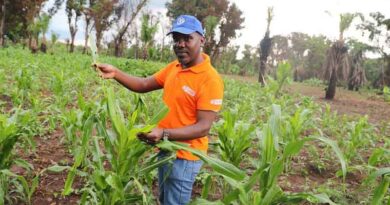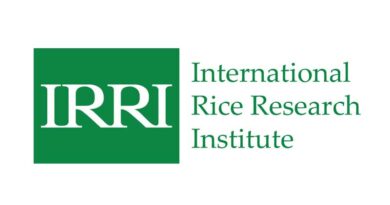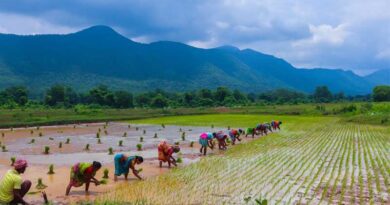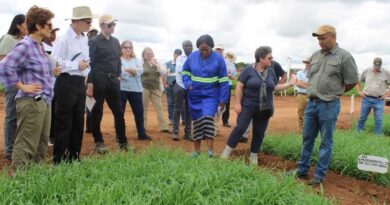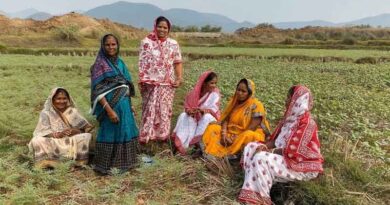Climate change-ready rice varieties: Prominent stride toward food security and sustainability
Guest Author: Dr. Kuntal Das, Senior Specialist, Seed System and Product Management, Research, Breeding and Innovation Platform, International Rice Research Institute, South Asia Regional Centre, Varanasi (UP), India.
05 September 2022, New Delhi: Agriculture is extremely vulnerable to climate change, and the negative effects of climate change are already being felt in the form of rising temperatures, rising sea levels, water scarcity, weather variability, shifting agroecosystem boundaries, invasive crops and pests, and other extreme weather events.
Climate change and the need for climate change-ready varieties:
Climate change reduces crop yields, nutritional quality, and productivity. Rice is the staple food for more than half of the world’s population, contributing to food security and providing a source of income for over 200 million smallholder farmers worldwide. Rice is primarily grown under anaerobic conditions, where it has adapted and evolved.
With Asia producing and consuming 90% of the world’s rice and conventional transplanted rice cultivation systems requiring a lot of water, it’s clear that water scarcity will have a big impact on rice production in the future. As a result of rising temperatures caused by the accumulation of greenhouse gases, the agricultural sector is likely to face another 10%-15% reduction in irrigation water by 2025. A rise in sea level, combined with more erratic and extreme weather events, will increase the risks of rice farming in addition to the direct effect of high temperatures.
As a result, the abiotic stresses that cause reduced rice productivity and acreage are expected to worsen as a result of climate change, which includes high temperature, drought, flooding, and salinity stresses. Each growing season, drought, flood, salt water, and extreme temperatures devastate crops and jeopardize the livelihoods of 144 million smallholder rice farmers. While high temperature is not currently a major issue, the other stresses are already common yield-limiting factors in the unfavorable tropical Asian environments where rice is widely grown.
Climate Smart Agriculture aims to achieve food security and sustainable agricultural development in the face of climate change. Climate change-ready crop varieties provide three benefits: increased agricultural productivity and income, increased adaptation and resilience to climate change, and reduced greenhouse gas emissions. Rice high-yielding varieties (HYV) have spread throughout both irrigated and rainfed areas, and now cover the majority of tropical Asia. However, these HYVs are invariably resistant to the current major abiotic stresses, which are likely to be exacerbated by severe climate change, such as drought, submergence, and salinity.
These stresses have reduced yields in millions of hectares of rice production areas, and modern HYVs have had a limited impact on these areas. Climate change is causing a convergence of technology with the need for future adaptation of rice varieties to changing climates. Incorporating tolerance to the major abiotic stresses (drought, flooding, salinity, and high temperature) into high-yielding varieties has proven to be a very effective approach for developing varieties that can cope with climatic change situations. These successes give hope that the problem of climate change can be addressed in part by developing and disseminating adapted stress-tolerant rice varieties (STRV) or climate change-ready rice varieties, which will provide significant protection against the adverse effects of climate change. Rapid progress has been made in the development of STRVs, and serious efforts have been made in the last decade for rapid dissemination to farmers in unfavorable growing environments, and this will be a continuing thrust in the future.
Submergence Tolerance:
Submergence tolerance is defined as the ability of a rice plant to survive and continue growing after being completely inundated in water for several days. Submergence can affect rice crops at any stage of growth and can be either short-term (flash floods) or long-term (stagnant flooding).
Flooding of water affects morphological and anatomical changes, such as leaf senescence, inhibition of growth in dry mass, faster underwater leaf elongation, partial injury, and even death of the entire plant. The chances of survival of rice plants are extremely low when completely submerged for long period during the crop’s vegetative stage. Out of 16.1 million hectares of rice-growing areas in India, 5.2 million are occasionally affected by the flood. The rice plant elongates its leaves and stems during flooding to escape submergence. Deepwater rice varieties are able to do this rapidly enough to survive. Many high-yielding modern varieties cannot elongate enough and lack submergence tolerance. Plant breeders have discovered a promising gene, called Sub1, which confers high tolerance to complete submergence of up to 14 days.
Drought Tolerance:
Drought tolerance refers to a plant’s ability to maintain biomass production in arid, drought, or water-stressed conditions. Drought is the most common and destructive environmental stress, affecting 23 million hectares of rainfed rice in South and Southeast Asia. Drought is the most serious threat to agricultural food production in the face of climate change. Drought intensity/severity is highly complex and is determined by a variety of factors such as rainfall frequency, evaporation, and soil moisture.
Severe drought in some Indian states can result in yield losses of up to 40%. Terminal drought occurs when a prolonged lack of water causes plant death, whereas intermittent drought occurs when a brief lack of water causes improper growth. Rice grain yield and vegetative growth are severely reduced when water is scarce. Drought stress frequently causes reductions in grain size, grain weight, and seed-setting rate. Several drought-tolerant varieties are being developed in the last decade and have been widely adopted.
Heat Tolerance:
A plant’s heat tolerance is its ability to produce an economic yield and grow normally under high-temperature conditions by adjusting its structural or metabolic properties. Global warming has had a significant impact on rice production. Though rice originated in the tropics, high temperatures during the reproductive stages reduce rice productivity by causing low seed setting and yield. Increased nighttime temperatures during the ripening stage reduce rice yield and grain quality.
Furthermore, heat stress can cause leaf yellowing and accelerated development even during the vegetative growth stage, resulting in low yield in sensitive rice varieties. Scientists are screening improved and traditional rice varieties for rice that can withstand high temperatures. These donors are used in a crossing program to incorporate high-temperature tolerance into elite rice lines in order to develop heat-tolerant varieties for ‘hot and dry’ and ‘hot and humid’ countries.
Salt-tolerant rice:
Salt tolerance in rice is defined as the ability to grow on land with a 0.3% saline/alkali concentration while producing a significant economic yield. Millions of hectares of rice-growing land in Asia and Africa are currently underutilized due to high salinity. Rising sea levels bring salt water further inland, contributing to soil salinity.
Salinity affects significant areas of land in coastal areas that could otherwise be used for rice farming. One of the most severe environmental stresses is salt stress. Salt stress causes osmotic stress, ionic toxicity, and nutritional deficiencies in plants, which eventually leads to growth inhibition and crop yield losses. In the past, salt tolerance varieties were developed in India and are now grown in large areas of the saline environment.
Multi-stress Tolerance:
Rice crops are frequently subjected to more than one abiotic stress during the growing season. As a result, recent research emphasis has been placed on the development of multiple stress-tolerant rice varieties (MSTRV). MSTRVs with a combination of stress tolerance genes for submergence, drought, heat, and salinity are being developed using conventional and molecular breeding approaches. Few of these varieties have been released in India, and many more are being developed to be available to farmers for cultivation shortly.
Table: Few prominent and modern climate change-ready rice varieties in India.
| Year of Release | Variety | Submergence Tolerant | Drought & Heat Tolerant | Salt Tolerant | Multistress Tolerant |
| 2005 | CSR 36 | + | |||
| 2007 | Shusk Samrat | + | |||
| 2009 | Narendra Usar Dhan 2008 | + | |||
| 2009 | Swarna Sub1 | + | |||
| 2010 | DRR Dhan 39 (Jagjeevan) | + | |||
| 2011 | Luna Sampad | + | |||
| 2011 | Sahbhagi Dhan | + | |||
| 2012 | CR Dhan 406 | + | |||
| 2013 | CR 1009 Sub1 | + | |||
| 2014 | Ciherang Sub1 (Bina 11) | + | |||
| 2014 | CR Dhan 201 (DRR 44) | + | |||
| 2014 | CSR 43 | + | |||
| 2015 | Bina Dhan 10 | + | |||
| 2015 | IR 64 Drt1 (DRR 42) | + | |||
| 2015 | Samba Mahsuri Sub1 | 1 | |||
| 2016 | Gosaba 5 (Chinsura Nona-1) | + | |||
| 2016 | Swarna Shreya | + | |||
| 2017 | Sabour Ardhajal | + | |||
| 2018 | Bahadur Sub1 | + | |||
| 2018 | Bina 17 | + | |||
| 2018 | CSR 46 | + | |||
| 2018 | CSR 60 | + | |||
| 2018 | DRR Dhan 47 | + | |||
| 2018 | DRR Dhan 50 | + | |||
| 2018 | Ranjit Sub1 | + | |||
| 2019 | CR Dhan 801 | + | |||
| 2019 | CR Dhan 802 | + | |||
| 2020 | Sabour Harshit | + | |||
| 2020 | Swarna Shakti Dhan | + | |||
| 2021 | IR 64 Sub1 | + |




